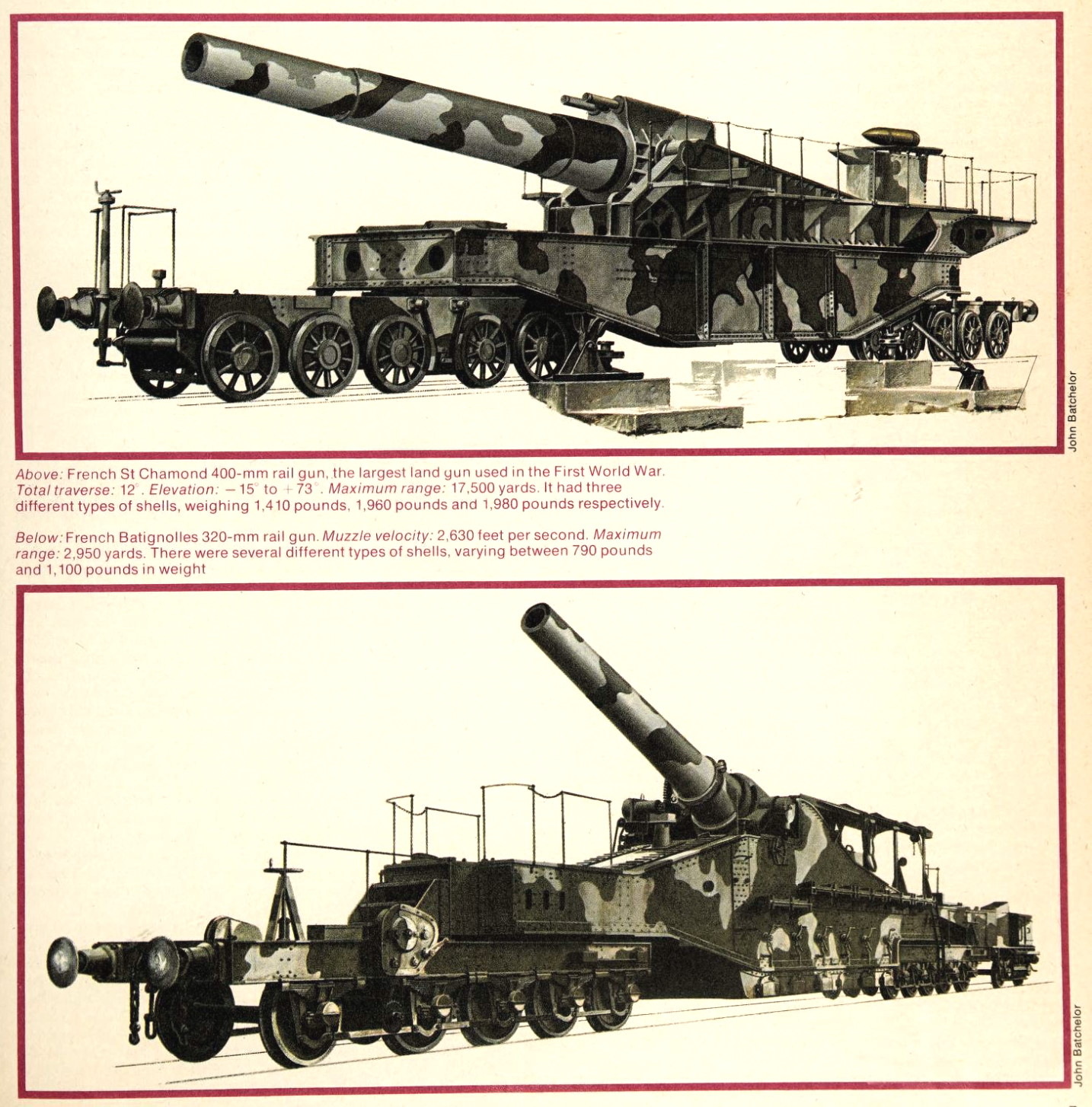
There were some heavy guns in the French armoury at the beginning of the First World War, but they were either in static fortress positions or awaiting installation in warships: the French philosophy of attack, mobility and rapid fire had no place for big guns. It reflects creditably on French designers that from some very crude rail-mounted guns they finished the war with efficient modern pieces which even included a massive 520-mm (20.5-in) gun. Some were in action in the Second World War Ind after the French defeat in 1940 passed into German hands. They included 305-mm (12-in), 320-mm (12.6-in), 340-mm (13.4-in) and 370-mm (14.5-in) guns and though most remained in France to back up the Atlantic Wall defences some were sent East. One 370- mm gun was in action as late as January 1945 against Soviet forces. Rail guns have passed into artillery history for, as one writer remarked, ‘improved reconnaissance methods have made it hard to conceal a soldier, so a massive gun with a railway line extending behind it becomes an easy target’. The
French built a large number of rail guns during the First World War; some were very crude lash-ups with guns taken from fortresses or naval pieces. Both types required a mount which could not be fitted on a railway flat car and as a result they were temporary arrangements which varied from gun to gun.
The 194-mm (7.6-in) mle 1875 was straight out of the nineteenth century coastal forts found in France and Britain. Guns like this and the more sophisticated Canon de 240-mm and 140-mm were mounted on sloping ramps which took some of the recoil, the rest was absorbed by the backward movement of the railway truck mounting. Some had ground anchors and could be cranked back into their firing position after each shot.
Canon de 240-mm modele 1884
This was one of the most widely used calibres in the French army. The mle 70-81 was comparatively crude and the mle 1893-96 and 1884 were not only more powerful but mounted on improved carriages. The Vasvasseur pattern carriage was similar to the inclined ramps of earlier designs, but with improved buffers recoil was reduced to 1.5 m (5 ft).
Canon de 240-mm modele 1893-96
A heavier piece, the mle 1893-96 had a 360-traverse platform on a well base wagon. It was also one of the first guns to be fired from a prepared platform-anchored mounting which was later to be incorporated into the Batignolles design.
Materiel de 274 modele 87, 93
This was the smallest calibre adapted by Schneider for a non-recoil sliding mount. The basic design was similar for their 274-mm (10.78-in), 285-mm (11.2-in), 305-mm (12-in) guns and howitzers. The 320-mm (12.6-in) 340-mm (13 4-in) and 370-mm (14.5-in) guns had a similar mount but with bigger bogies to take the greater weight. The basic design consisted of two heavy side plates rigidly connected by an elaborate system of cross transoms to make a rigid box. The side members accepted the gun trunnions in a reinforced area with a solid steel bushing to take the shock of recoil.
Materiel de 400 modele 15, 16
This rebored ex-naval gun was shortened and turned into a howitzer by St Chamond. It was fired from a Batignolles emplacement though the majority of the recoil force was taken by the hydro-pneumatic buffers. The Batignolles mount was also used on the 305-mm (12-in) mle 93/06 and 370-mm (14.5-in ) mle 1887
Obusier de 520 mle 16
This piece was a product of Gallic pride and political pressure. After the Germans had deployed 42-cm (16.5-in) howitzers against the Belgian forts and French forts at Verdun the French demanded a bigger gun. The 520 mm (20.5-in) howitzer was built and paraded for politicians. It saw little action, but is of interest as the only gun to be designed during the war rather than adapted from existing prewar stocks. Two were built, but since they weighed 255 tonnes, took three hours to emplace and only had a range of 14600 m (15965 yards ) they were expensive luxuries.